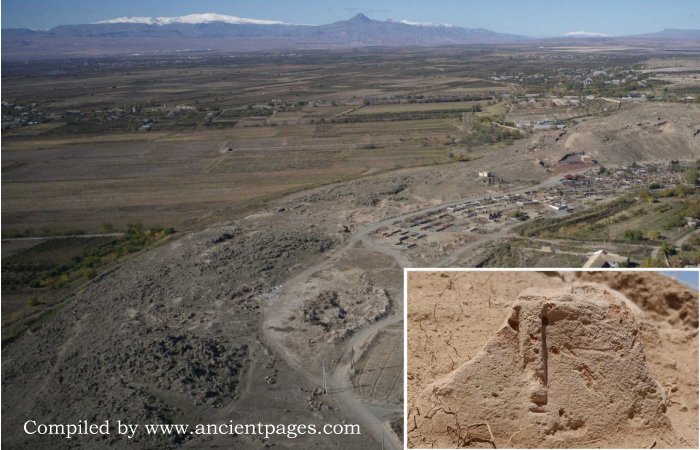Conny Waters – AncientPages.com – Urartu was a significant state that emerged in the first millennium B.C. in Anatolia, now modern Turkey, following the fall of the Hittite state around 1200 B.C. Other states from this period include Phrygia, Tabal, and Lydia. Each of these kingdoms had distinct languages, ethnicities, religions, and material cultures.
The Argishtikhinili site. View of the Davti Blur Hill. Credit: P. Okrajek
Urartu was located near Lake Van and occupied a strategic mountainous plateau between Anatolia, Mesopotamia, the Iranian Plateau, and the Caucasus Mountains until its destruction. It is referenced in Assyrian records from as early as the 13th century B.C. and held substantial political influence in the Middle East during the 9th and 8th centuries B.C. By the 6th century BCE, Urartu’s presence was succeeded by that of the Armenians in this region.
Argishtikhinili is situated on Surb Davti Blur Hill, also known as Saint David’s Hill, in the village of Nor Armavir within Armavir Province. This settlement likely dates back to around 776 BCE, founded by King Argishti I, as indicated by a foundation inscription found nearby in Sardarapat. In Urartian texts, Argishtikhinili is described as a city with significant economic infrastructure supported by four irrigation canals drawing water from the Arax River.
Ancient urns found at the site. Credit: P. Okrajek
The city featured two main citadels: one located on the western part of Surb Davti Blur Hill and another on Armavir Blur Hill. Research indicates that there was an expansive area between these citadels that likely lacked its own fortifications. The best-preserved section of this ancient Urartian city is found in the central and eastern parts of Surb Davti Blur Hill.
Between the 1960s and 1980s, archaeologists discovered nine large residences here, likely belonging to elite members of society. Additionally, remains of twenty more houses were documented along pathways running from west to east. An architectural complex in the eastern part of the hill is currently being studied by an Armenian-Polish mission.
Recent findings from this mission’s second season have been released. Excavations in residential areas and an urn-field cemetery have provided new insights into daily life and spiritual practices 2,500 years ago.
The Armenian-Polish Archaeological Expedition is led by Dr. Mateusz Iskra from the Polish Centre of Mediterranean Archaeology at the University of Warsaw (PCMA UW) and Hasmik Simonyan from Armenia’s National Academy Institute for Archaeology and Ethnography. Their research focuses on St. David’s Hill (Surb Davti Blur), a mound that hosts the remains of this fortified city. Recent studies have concentrated on large terraced houses with ground-floor areas approximately 400 m² in size, preliminarily dated to between the late 7th century B.C. and the early 6th century B.C.
Their state of preservation turned out to be surprisingly good. In many places, floors paved with mud-brick and stone paving have survived intact,” says Dr. Iskra, who is also the head of the Department of Near Eastern Studies at the PCMA UW.
Due to the excellent state of preservation, archaeologists have made several discoveries that provide new insights into the daily life of the city’s former inhabitants. In one house, researchers found a storeroom with large storage vessels still embedded in the floor. However, an extraordinary discovery was made in an adjacent room.
“Leaning against the side of a stone box, we found – to our surprise – a stone with carved human features. It was a figurine-idol, preserved in its original position,” Dr. Iskra said in a press release.
The researchers found a 2,500-year-old volcanic tuff idol at the site. Credit: P. Okrajek
The figure, standing about half a meter tall, is intricately carved from volcanic tuff and depicts a stylized face with distinct eyebrows, closely set eyes, a long nose, and narrow lips. Archaeologists have identified similar idols at various sites across Armenia, suggesting they may be associated with local ancestor or fertility cults.
To gain further insight into the idol’s purpose at Argishtikhinili, researchers plan to conduct chemical analyses on the contents of the stone chest in hopes of uncovering clues to this fascinating mystery. Additionally, this season’s remarkable findings include an expansive urn field cemetery containing numerous cremation burials.
The ashes of the deceased had been carefully placed in ceramic vessels, often accompanied by grave goods,” – explains Hasmik Simonyan, who specializes in bioarchaeology. She adds that this find marks a milestone in Armenian archaeology, both in terms of the burial ground’s scale and the wealth of knowledge it offers, for it is, most likely, the largest and best-preserved urn-field cemetery in Armenia discovered so far.
See also: More Archaeology News
The exceptional preservation of the urns provides researchers with valuable insights into the funerary customs and rituals of communities influenced by Urartu. This discovery offers new perspectives on the social structure, beliefs, and regional interactions of the inhabitants of this area during the first millennium B.C.
The excavations are a collaborative effort between Armenian and Polish archaeologists, highlighting their enduring academic partnership. This finding not only reinforces their cooperation but also sets the stage for further intriguing research into the ancient history of the South Caucasus.
Written by Conny Waters – AncientPages.com Staff Writer








